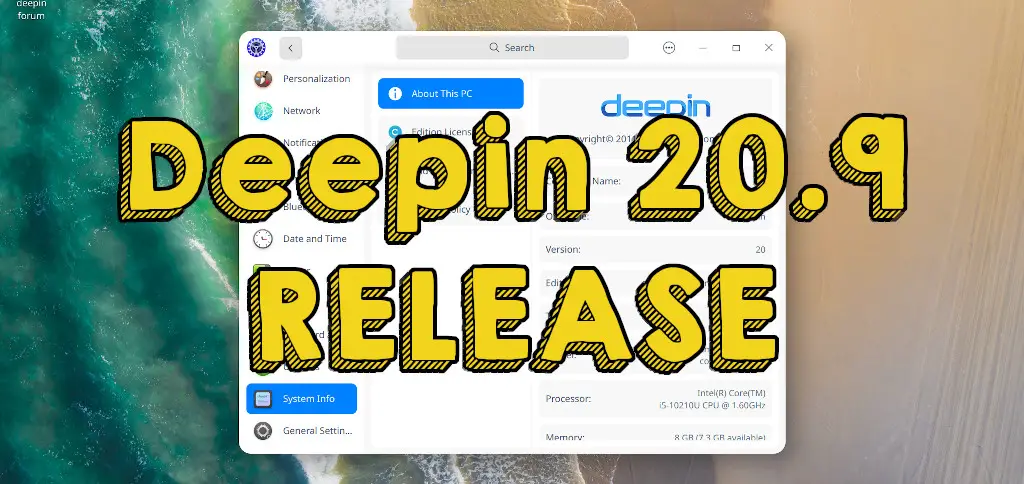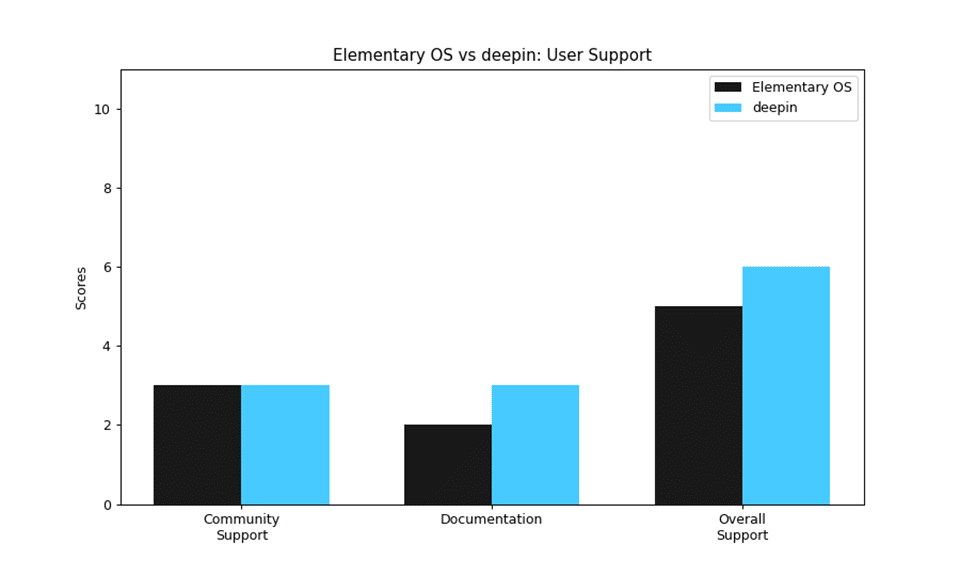Elementary OS vs. Deepin: Aesthetics and User Experience Compared

Elementary OS and Deepin are two Linux-based operating systems that place a strong emphasis on aesthetics and user experience. Both distros feature polished and intuitive interfaces, but they differ in several key areas.

Interface Design:

Elementary OS has a clean and minimalist interface that utilizes the GNOME desktop environment with the Pantheon desktop shell. The desktop is characterized by a single panel located at the bottom of the screen, which contains the system tray, application menu, and workspace switcher. Applications follow a consistent design language with rounded corners and monochrome icons.
Deepin, on the other hand, employs its custom desktop environment, Deepin Desktop Environment (DDE). DDE features a more traditional layout with a panel at the bottom and a dock on the left side. The desktop is adorned with vibrant colors, gradients, and transparency effects. Applications also have a distinctive look, with rounded corners and a flat design.
Application Ecosystem:
Elementary OS primarily includes applications from the GNOME ecosystem, such as Nautilus for file management, Gedit for text editing, and Rhythmbox for music playback. It also provides a curated AppCenter with select third-party applications.
Deepin comes pre-installed with a range of Deepin-developed applications, including DMusic for music, Deepin File Manager for file management, and Deepin Terminal for shell access. It also has a Deepin Store that offers a wider selection of applications, including many popular Linux software.
Performance:
Both Elementary OS and Deepin are known for their relatively lightweight performance. Elementary OS is optimized to run smoothly on low-end hardware, while Deepin is designed for a more immersive experience on modern computers.
Customization:
Elementary OS provides limited customization options for users. The desktop layout is fixed, and users have minimal control over the appearance of the interface. However, they can personalize their wallpapers, themes, and cursors.
Deepin offers a wider range of customization options. Users can adjust the panel layout, change the dock position, and apply custom themes. They can also install extensions to further enhance the functionality of the desktop environment.
Conclusion:
Elementary OS and Deepin are both visually appealing and user-friendly Linux distros. However, they differ in their design philosophies and target audiences. Elementary OS is ideal for those who prefer a minimalist and simplified interface, while Deepin is geared toward users who enjoy customization and a more vibrant desktop environment. Ultimately, the choice between the two distros depends on individual user preferences and needs.## [Elementary OS Vs. Deepin: Aesthetics And User Experience Compared]
Executive Summary
This article presents a detailed comparative analysis of Elementary OS and Deepin, scrutinizing their aesthetics and user experience. It explores key aspects such as desktop environment, customization, themes, visual appeal, and ease of use, offering insights to help users make informed decisions based on their preferences. Ultimately, the choice between Elementary OS and Deepin hinges on individual priorities and aesthetic sensibilities, as both operating systems offer unique strengths.
Introduction
Elementary OS and Deepin stand out in the Linux distribution landscape, renowned for their unwavering commitment to aesthetics and user experience. While Elementary OS epitomizes simplicity and elegance, Deepin embraces a distinctive modern design. This article delves into a side-by-side analysis, contrasting the intricacies of these operating systems to illuminate their intrinsic qualities.
Desktop Environment
Elementary OS and Deepin adopt distinctive approaches to desktop environments, shaping the overall user experience.
-
Elementary OS:
- Pantheon Desktop: Pantheon embodies simplicity, mirroring macOS with its clean, uncluttered interface.
- Dock: Inspired by Plank, the dock seamlessly blends into the desktop, providing quick access to applications.
- Plank: The advanced dock customization options enable users to personalize their workspaces, reflecting their preferences.
-
Deepin:
- DDE (Deepin Desktop Environment): DDE strikes a balance between elegance and functionality, featuring an innovative dock and task manager.
- Deepin Dock: The customizable dock offers rapid access to commonly used applications, streamlining workflow.
- Control Center: Centralized system settings accessible through a modern and intuitive interface enhance user efficiency.
Customization
Customization empowers users to tailor their operating systems to match their aesthetic sensibilities and functional needs.
-
Elementary OS:
- Themes: Select from a curated collection of sleek, pre-installed themes to transform the desktop’s appearance.
- Icon Pack: Elementary OS provides minimal, cohesive icon sets that complement the OS’s overall aesthetics.
- Keyboard Shortcuts: Extensive keyboard shortcuts accelerate navigation and enhance productivity, appealing to power users.
-
Deepin:
- Deepin Store: Discover a vast array of themes, wallpapers, and icons to customize the desktop environment.
- Icon Customization: Users can personalize icons by altering their size, shape, and color, infusing individuality into their desktops.
- Window Management: Utilize multiple workspaces, snap windows to screen edges, and employ keyboard shortcuts for efficient window management.
Themes
Themes profoundly influence the system’s visual aesthetics, appealing to users with specific preferences.
-
Elementary OS:
- Default Light Theme: The default theme emphasizes clarity and simplicity, utilizing predominantly white and gray hues.
- Dark Theme: Embrace a darker interface that reduces eye strain, particularly during extended work sessions.
- Custom Themes: Create or download custom themes to unleash limitless design possibilities.
-
Deepin:
- Default Dark Theme: The default theme exudes sophistication, leveraging a dark color scheme accented by vibrant elements.
- White Theme: For those who prefer a brighter workspace, the white theme offers a refreshing alternative.
- Community Themes: Access a diverse repository of user-created themes to enhance the visual experience.
Visual Appeal
Visual appeal plays a crucial role in enhancing user engagement and satisfaction.
-
Elementary OS:
- Minimalist Design: Elementary OS prides itself on its minimalist design, prioritizing uncluttered spaces and understated elegance.
- Attention to Detail: Meticulous attention to design details ensures a cohesive visual experience across all elements.
- Consistency: The consistent design philosophy extends from the desktop environment to applications, fostering a sense of unity.
-
Deepin:
- Modern Aesthetics: Deepin embraces modern aesthetics, incorporating vibrant colors, fluid animations, and eye-catching visuals.
- Dynamic Wallpaper: The dynamic wallpaper feature transforms the desktop background based on time-of-day lighting conditions.
- Translucency Effects: Translucency effects enhance visual appeal, adding depth and sophistication to the interface.
Ease of Use
Effortless navigation and intuitive functionality contribute to a seamless user experience.
-
Elementary OS:
- Beginner-Friendly: Elementary OS is widely regarded as an ideal choice for Linux beginners, thanks to its intuitive interface and user-friendly design.
- Guided Installer: The streamlined installation process guides users through each step, making it accessible to all skill levels.
- Comprehensive Documentation: Extensive documentation and community support ensure that users can easily find answers to their questions.
-
Deepin:
- Comprehensive Tutorial: New users are welcomed by a comprehensive tutorial that introduces the operating system’s key features.
- Well-Organized Menus: Navigating through menus is effortless, as they are logically organized and easy to understand.
- Contextual Help: Hovering over interface elements provides contextual help, offering instant assistance when needed.
Conclusion
Elementary OS and Deepin present distinct yet compelling options for users seeking a refined and user-friendly Linux experience. Elementary OS excels in simplicity and minimalism, attracting those who value a clean and uncluttered workspace. Deepin, on the other hand, immerses users in a visually stunning environment, brimming with modern design elements and vibrant aesthetics. Ultimately, the choice between these two operating systems rests on personal preferences, with Elementary OS catering to those who prioritize simplicity and Deepin resonating with those who seek a more visually captivating experience.
Keyword Phrase Tags:
- Elementary OS
- Deepin
- Linux Distribution
- Desktop Environment
- User Experience

Gratz! its good
bad and very bad
Awsome! Elementary Os is great
Deepin is better
Elementary OS Looks Great
Elementary Os has a better user experience
This is amazing
Elementary OS is the best
Amazing, better than i thought
Deepin is awsome